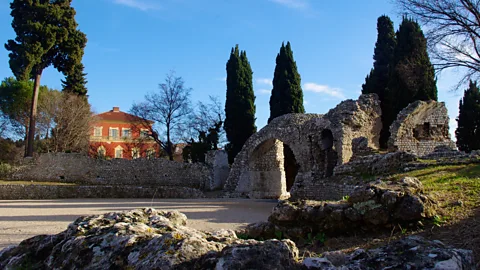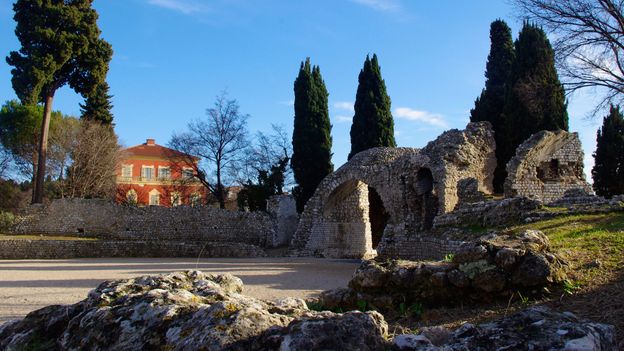
From artistic museums and ample public transportation to fresh Mediterranean cuisine and sultry beaches, experience the best of the Côte d’Azur without draining your bank account.
The south of
France conjures up images of old world glamour and luxury. But yacht-owning
Russian oligarchs, aging celebrities and wealthy retirees aside, Nice is
largely a working class city and many of its restaurants and attractions cater
to the roughly 345,000 residents who earn an average of 1,600 euros a month.
From free
museums and affordable public transportation to fresh Mediterranean cuisine and
sultry beaches, there is a plethora of inexpensive things to do in and around
the city. In fact, with a bakery on nearly every corner and a number of vineyard regions nearby, some of the things that France is famous for – such as
delicious wine and beautiful patisseries – cost less in Nice than practically
anywhere else in the world. And southern France’s most sought after export –
the laid back, sun drenched, lifestyle – does not cost a thing. Armed with such
local secrets, it is absolutely possible to experience the best of the Côte d’Azur without draining your bank account.
Soak up the culture
Modern day
Nice sits on what is thought to be some of the first evidence of human activity
in Europe. The city’s free archaeological museum, in the upscale Cimiez neighbourhood, is situated
in what was the Cemenelum – or the Roman capital of the region. Standouts of
the museum are the preserved ruins of the Roman baths and amphitheatre dating
back to the 3rd Century.
Also in
Cimiez, found through a dense olive grove, is a 17th-century Genoese villa, which houses the Henri Matisse Museum. The collection, given to the city by the artist and
his heirs, includes paintings, drawings, sculptures, photography and prints,
most of which Matisse completed during the nearly four decades he spent in
Nice. He lived nearby in the Hotel Regina (now a glamorous apartment building at 71
Boulevard Cimiez) from 1917 to 1954. Admission to the museum is free and the stunning
setting alone merits a visit.
For more
recent history, the modern art museum MAMAC, also free, has an impressive but manageable
collection of works by everyone from Andy Warhol to Niki de Saint Phalle, and a whole room is dedicated to native son
Yves Klein’s artworks in his famous deep blue hue. Centrally located on the edge
of Place Garibaldi, the museum’s roof terrace – with its sweeping views of the ochre
buildings and Mediterranean Sea below – is just as stunning as the things
hanging on the walls.
If you are
after glamour and sophistication, spend an evening at L’Opera
de Nice, the opera
house located in Vieux Nice, the
city’s cobblestone Old Town. Drenched in red velvet with golden-hued frescoes
on the ceiling, the sumptuous interior is a beautiful place to take in one of the ballets, operas and
symphonies that grace the stage throughout the year. Upcoming shows include performances by the Nice Ballet; nosebleed seats start at just 8
euros.
Taste the
Riviera
Tourist traps
abound in Nice, especially along the touristy pedestrian streets of Cours
Selaya and Rue de France, so it takes some sleuthing to find genuinely good
restaurants that do not cost a fortune. The region’s traditional cuisine is
more Mediterranean than French (think olive oil instead of butter and simple dishes
using produce and fresh fish), so when in doubt, stick with understated eateries
that specialise in Niçoise cooking. Soupe de poisson (seafood soup) served with
garlic aioli, croutons and cheese is on most menus and you cannot go wrong with
house made pastas or simply prepared fresh fish; also be sure to order the house wine.
Socca (a thin, flat, pancake made of
chickpea flour) is the local specialty, and Renee Socca (2 Rue Miralheti; 93-92-05-73), a casual cafe in Vieux
Nice, is the place to try it. To order your food, line up at the
counter next to the brick oven and watch the huge round trays of piping hot
socca being prepared. You must order a drink to sit at a table, but socca,
served slightly crispy around the edges and sprinkled with salt, is best washed
down with a beer or glass of chilled rosé anyway, so take a seat and enjoy a
casual lunch or afternoon snack. A glass of house wine costs 1.80 euros and a
steaming plate piled high with pieces of socca is three euros.
For a
pre-dinner drink and appetiser, Distilleries Ideals,
also in Vieux Nice, is one of the most popular spots in town. A favourite of
locals and visitors alike, the bar serves a selection of imported draught beers
and local wines from the nearby Bandol and Bellet regions. The limited but high-quality
snack menu includes cheese and charcuterie plates. Snag a coveted seat outside
and enjoy the golden light and lively atmosphere as the sun goes down. A cheese
plate and two glasses of house wine costs less than 12 euros.
For a more refined experience, make a reservation
at Chez Palmyre (5 Rue Droite; 93-85-72-32). The
cosy, family run restaurant has been cooking the same hearty Niçoise fare for nearly a century. Tucked away on a narrow Vieux Nice
street, this restaurant is quaint and welcoming, with friendly service and
fantastic food. The weekly-changing menu has local specialities like hearty
pork sausages with puy lentils and ravioli au
daube (handmade meat ravioli with beef sauce, slow cooked in a clay pot). A
three-course menu with a starter, entrée and dessert costs only 15 euros and though the wine
list is small with just a few local options, it is only five euros for a pitcher of
house wine. Of
course nothing in Nice is without quirks – every restaurant here seems to
employ their own eccentric opening hours, and Chez Palmyre is no exception.
They are closed on weekends and you must book in advance. The restaurant has
only a dozen tables, and they fill up fast.
The
neighbourhood of La Libération, about 2km
north of Vieux Nice, is full of little shops selling fresh pasta (Nice is known
for its ravioli and claims to have invented gnocchi), and in the spring and autumn
the neighbourhood seafood restaurants shuck oysters al fresco. Le Marché de Libération,
which is open Tuesday through Sunday from 7 am until 1 pm, is a produce market
that has been kept off the tourist radar for decades. Stalls of seasonal fruits,
vegetables, homemade jams, fresh eggs and an impressive fish selection line the
tramway along Rue Malausséna, which runs through the neighbourhood. Their
prices are half as much as at the famous Cours Salaya market down by the seafront.
Also on Rue
Malausséna, Arlequin Gelato has some of
the best gelato in Nice – and with more gelaterias per capita than seems
reasonable, that is saying something.
Roberto Francia, the jovial proprietor of the shop, lives in a world of
flavours, and his rotating list of fruity and creamy confections are proof of
his talent. The taste of his gelatos are so pure you might think you are biting
into a sweet persimmon or a handful of salty pistachios – and at two euros a
scoop, you can try them all.
Every
neighbourhood has a few bakeries where each pastry is a tiny work of art, and
there is no better way to people watch than with a delectable patisserie and a
coffee in hand. Sidi Bou Said (26 rue de Paris; 93-80-04-13) in the Thieirs
neighbourhood, has been serving Tunisian sweets, such as coconut-filled
chocolates and sticky pistachio pastries, in this location for 40 years. The
colourful piles of cookies and cakes in the centre of the small cafe cost about
one euro each and every day at 4 pm they serve fresh, hot beignets dusted with
sugar for only 1.50 euros each.
Get out of town
Nice has
fantastic public transportation with high-speed trains, a modern tramway and
comprehensive bus routes. SNCF trains runs along the coast from
Italy to Marseille, so a trip east to the Italian boarder or west to Cannes is
as easy as climbing aboard and shelling out around five to 15 euros depending
on where you are going. The Lignes d’Azur line of
buses go up and down the coast – and although a slightly less comfortable and
slower journey, the incredibly scenic routes run throughout the region to
places like Grasse to the west and sun-soaked Menton to the east. Nice’s modern tramway route makes a giant “U”
through the city with 21 stops along the way.
Busses and trams both cost only one euro no matter how far you
go.
Along with
most progressive cities around the world, Nice has a fantastic bike share
system. Every neighbourhood in the city is equipped with neat rows of Vélo Bleu racks where you can rent a bike for
next to nothing. The first 30 minutes are free, and then it costs one euro per
hour after that. Take a spin along the picturesque Promenade des Anglais,
Nice’s iconic 5km palm tree-lined pedestrian path that stretches around the
seafront.
Contrary to
popular belief, most of the beaches along the Baie des Anges, the city’s coastline, are public. But be
forewarned; apart from the occasional truckload of sand brought in for beach
volleyball, the shore is made up of large smooth pebbles. For soft, sandy
public beaches, the neighbouring towns of Antibes and Juan Les Pins, 20km to
26km southwest of Nice, have some of the best in the area and both are accessible
by train or bus. Once there, a seaside picnic costs no more than the price of a
fresh crusty baguette and a hunk of gooey Camembert, but the sublime feeling of
the sun on your face and the sound of the waves crashing nearby is what dreams
are made of.
Get some rest
There is no
shortage of hotels in France’s fifth largest city, but most of the ones
scattered near Gare de Nice Ville, the main train station, should be avoided. Hotel Berlioz, located just a few blocks from the station in Thiers, is a rare
exception with clean, well-appointed rooms for around 50 euros a night. If you can stretch your budget, 100 euros
a night in the low season (September to April) will get you outstanding sea
views at the Hotel Suisse,
perched on the side of Castel Hill overlooking Nice’s famous coastline.
For basement rates, Les Camelias is a lively
youth hostel located midway between the Carabacel and Medecin neighbourhoods. The
courtyard is shaded by avocado and orange trees and 22.60 euros a night will get you a clean, bright, shared room and
breakfast in the morning.
For a more
unique stay, Hotel Victor
Hugo, located directly across from the Jardin Alsace-Lorraine park in the
Gambetta neighbourhood, is near both the beach and the main shopping area. The
small boutique hotel consists of nine rooms on the renovated ground floor of a
century old building. The owner Giles Demay, a former concierge in Paris,
is committed to service of the highest standard and it shows. Rooms start at 75 euros and are equipped with kitchenettes and
wi-fi, with breakfast included.



